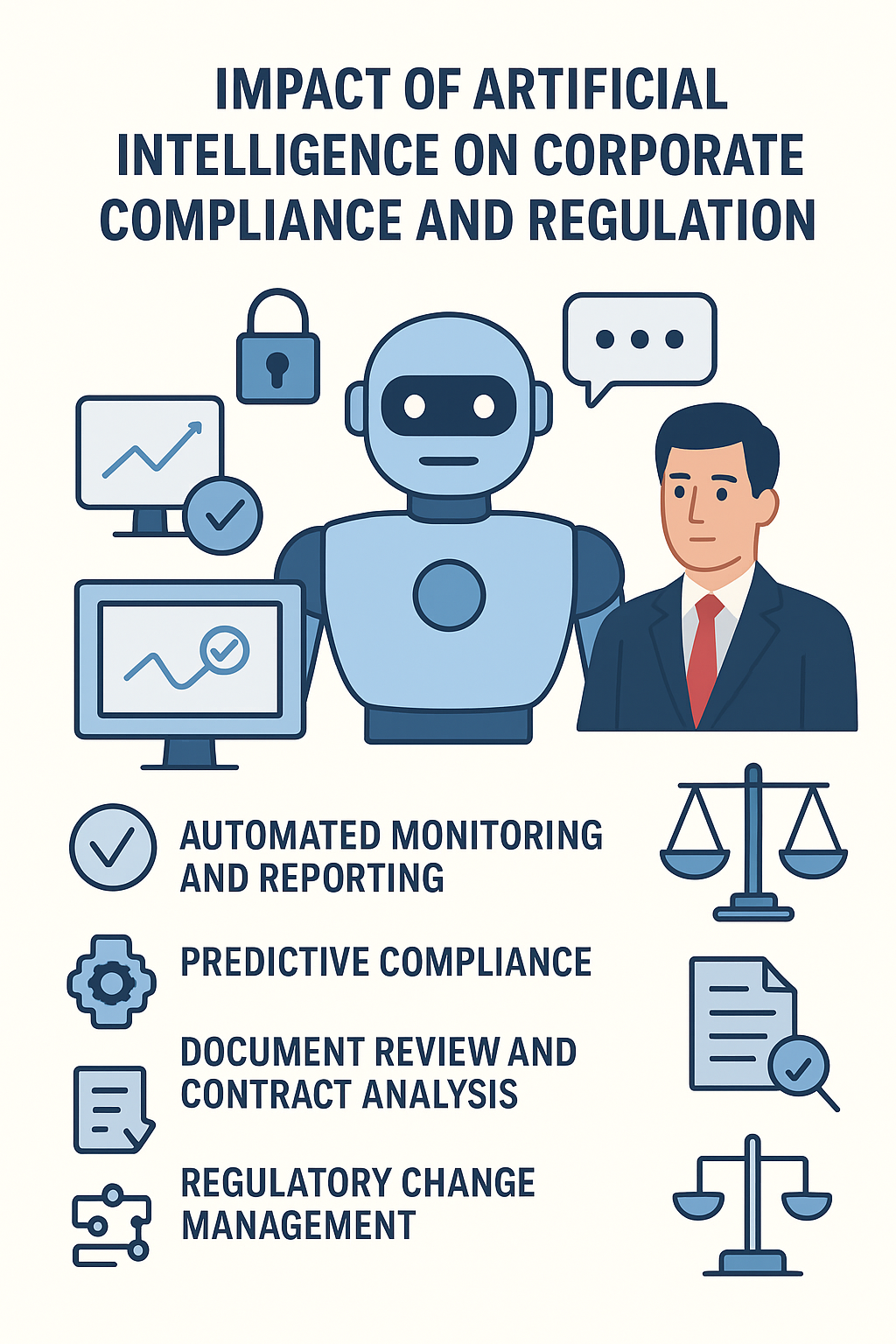View News
Impact of Artificial Intelligence on Corporate Compliance and Regulation

Impact of Artificial Intelligence on Corporate Compliance and Regulation
Introduction
Artificial Intelligence (AI) has rapidly transitioned from being a futuristic concept to becoming an indispensable tool in modern corporate operations. Its integration into compliance and regulatory frameworks has revolutionized the way businesses monitor risks, ensure adherence to laws, and safeguard corporate governance standards. AI enables real-time monitoring of transactions, predictive risk assessments, and proactive detection of potential violations—capabilities that far surpass traditional compliance mechanisms.
However, while the benefits are substantial, AI adoption introduces new challenges, including questions of accountability, legal liability, data protection, and ethical use. Global regulators are simultaneously exploring ways to incorporate AI into existing legal frameworks while ensuring that transparency, accountability, and stakeholder trust are not compromised. This paper examines the applications of AI in corporate compliance, the legal and regulatory challenges it creates, global regulatory responses, and risk mitigation strategies for corporations.
AI in Corporate Compliance: Key Applications
Corporate compliance requires adherence to statutory laws, regulatory frameworks, and ethical business practices. AI has significantly transformed this space by introducing automation, efficiency, and predictive capabilities. Major applications include:
-
Automated Monitoring and Reporting
-
AI-powered compliance platforms can analyze vast datasets in real time to detect anomalies, suspicious transactions, or potential breaches of regulatory requirements.
-
For example, financial institutions deploy AI-driven systems to comply with Anti-Money Laundering (AML) and Know Your Customer (KYC) regulations by flagging unusual financial activities.
-
-
Predictive Compliance
-
Machine learning models identify patterns and trends that indicate possible future violations, enabling companies to take preventive measures before regulatory breaches occur.
-
Predictive analytics helps compliance teams prioritize high-risk areas, reducing both regulatory risk and operational inefficiencies.
-
-
Document Review and Contract Analysis
-
Natural Language Processing (NLP) algorithms review contracts, policies, and legal documents to highlight regulatory red flags or non-compliance clauses.
-
This reduces manual workload for compliance officers and enhances accuracy in detecting legal risks.
-
-
Regulatory Change Management
-
AI tools track global regulatory developments across multiple jurisdictions and automatically update compliance requirements.
-
For multinational corporations, this ensures timely adaptation to evolving laws such as the EU AI Act, GDPR, or industry-specific financial regulations.
-
Impact: These applications lower compliance costs, improve monitoring precision, enhance governance standards, and allow corporations to allocate human resources toward strategic compliance decision-making rather than repetitive tasks.
Legal and Regulatory Challenges of AI in Compliance
While AI offers significant advantages, its integration into compliance systems introduces several complex legal and regulatory concerns:
-
Accountability and Liability
-
AI systems often function as decision-making aids, such as rejecting a transaction or flagging misconduct. Errors or false positives create ambiguity in liability.
-
Under corporate law, directors and officers remain legally accountable, but the "black box problem" of AI—its opaque decision-making process—complicates establishing responsibility.
-
-
Discrimination and Bias
-
If trained on biased datasets, AI models can perpetuate or amplify discrimination in areas such as lending decisions, recruitment, and customer service.
-
Such biases can expose corporations to violations of civil rights laws, Equal Opportunity provisions, and consumer protection regulations.
-
-
Data Protection and Privacy
-
AI systems require access to sensitive personal and corporate data. Their use must comply with strict privacy laws such as:
-
General Data Protection Regulation (GDPR) – EU
-
Digital Personal Data Protection Act, 2023 – India
-
-
Non-compliance may result in penalties, litigation, and reputational harm.
-
-
Cross-Border Regulatory Compliance
-
Multinational corporations face fragmented AI regulatory frameworks.
-
For example, the EU AI Act categorizes certain AI applications as “high-risk” and mandates rigorous compliance, while other jurisdictions may adopt a lighter regulatory touch.
-
-
Intellectual Property (IP) Concerns
-
Ownership of AI-generated compliance reports, datasets, or recommendations may be disputed if third-party AI tools are used without explicit contractual terms.
-
Risks include copyright infringement, trade secret misappropriation, and disputes over derivative works.
-
Emerging Global Regulatory Responses
Governments and international organizations are actively shaping regulatory frameworks for AI governance. Key developments include:
-
European Union (EU) – AI Act
-
Establishes a risk-based approach to AI regulation.
-
Imposes strict requirements for “high-risk” AI applications, including transparency, human oversight, and conformity assessments.
-
-
United States
-
Regulatory bodies such as the Federal Trade Commission (FTC) and Securities and Exchange Commission (SEC) have issued guidance on AI use in trading, disclosures, and consumer protection.
-
Focus remains on transparency, fairness, and avoiding deceptive practices.
-
-
OECD AI Principles
-
Promote international best practices emphasizing accountability, transparency, fairness, and respect for human rights.
-
-
India
-
While no dedicated AI legislation exists, sector-specific regulators (e.g., the Reserve Bank of India) have issued governance guidelines for AI deployment in fintech and financial compliance.
-
Implication: These frameworks aim to balance AI innovation with safeguards that ensure fairness, human oversight, and corporate accountability.
Risk Mitigation Strategies for Corporations
To responsibly integrate AI into compliance functions, corporations must adopt structured governance mechanisms:
-
AI Governance Policy
-
Establish internal policies outlining permissible AI use cases, accountability structures, escalation mechanisms, and documentation protocols.
-
-
Human-in-the-Loop Oversight
-
Retain human review of AI outputs in critical decisions, particularly those with legal, financial, or ethical implications.
-
-
Algorithmic Transparency
-
Maintain detailed documentation of AI models, including training datasets, decision logic, and system architecture, to facilitate audits and regulatory inspections.
-
-
Bias Audits and Ethical Reviews
-
Conduct periodic independent audits to identify discriminatory outcomes and implement corrective measures.
-
-
Cross-Jurisdictional Compliance Mapping
-
Develop matrices comparing AI-related legal obligations across operating regions to ensure global compliance alignment.
-
-
Data Security and Privacy Controls
-
Implement encryption, anonymization, and access controls to safeguard datasets used in AI development and operations.
-
Policy and Ethical Considerations
Beyond legal compliance, corporations must address broader ethical and policy concerns associated with AI:
-
Employment and Workforce Impact
-
AI-driven automation may displace certain job roles. Ethical corporate policies should consider retraining and reskilling initiatives.
-
-
Stakeholder Transparency
-
Clear communication with investors, employees, and customers about AI use builds trust and minimizes reputational risk.
-
-
Explainability Principle
-
AI systems should provide justifiable explanations for their decisions.
-
This aligns with corporate governance duties of directors, who must act responsibly and in the best interests of the company.
-
Failure to adopt ethical AI practices may not only result in legal sanctions but also erode stakeholder confidence—potentially causing greater harm than regulatory penalties.
Conclusion
Artificial Intelligence presents transformative opportunities for strengthening corporate compliance through automation, predictive monitoring, and efficient regulatory management. Yet, its adoption also raises significant challenges relating to accountability, bias, data privacy, intellectual property, and regulatory fragmentation.
The path forward requires a balanced approach: integrating AI responsibly while ensuring strong governance, ethical safeguards, and transparency. Corporations that adopt robust AI governance policies—covering legal compliance, ethical responsibility, and technological explainability—will not only meet regulatory expectations but also enhance stakeholder trust.
In an AI-driven corporate landscape, organizations that manage compliance with foresight and integrity will gain a competitive edge, transforming regulatory obligations into opportunities for stronger governance and sustainable growth.
"Unlock the Potential of Legal Expertise with LegalMantra.net - Your Trusted Legal Consultancy Partner”
Disclaimer: Every effort has been made to avoid errors or omissions in this material in spite of this, errors may creep in. Any mistake, error or discrepancy noted may be brought to our notice which shall be taken care of in the next edition In no event the author shall be liable for any direct indirect, special or incidental damage resulting from or arising out of or in connection with the use of this information Many sources have been considered including Newspapers, Journals, Bare Acts, Case Materials , Charted Secretary, Research Papers etc
-Prerna Yadav
LegalMantra.net Team

